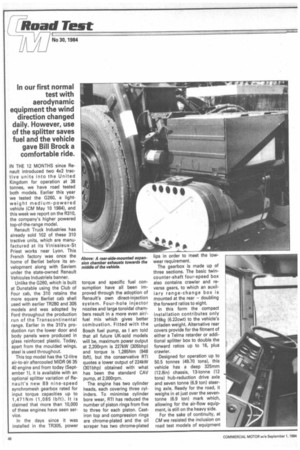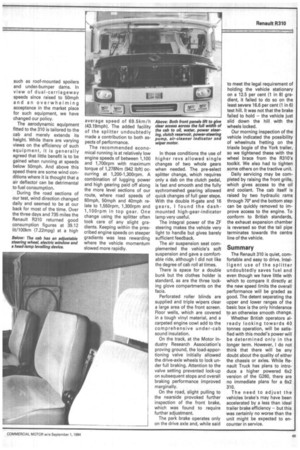In our first normal test with aerodynamic equipment the wind
Page 50

Page 51

If you've noticed an error in this article please click here to report it so we can fix it.
direction changed daily. However, use of the splitter saves fuel and the vehicle gave Bill Brock a comfortable ride.
IN THE 12 MONTHS since Renault introduced two 4x2 tractive units into the United Kingdom for operation at 38 tonnes, we have road tested both models. Earlier this year we tested the G260, a lightweight medium-powered vehicle (CM May 10 1984), and this week we report on the R310, the company's higher powered top-of-the-range model.
Renault Truck Industries has already sold 102 of these 310 tractive units, which are manufactured at its Vinissieux-St Priest works near Lyon. This French factory was once the home of Berliet before its envelopment along with Saviem under the state-owned Renault Vehicules lndustriels banner.
Unlike the G260, which is built at Dunstable using the Club of Four cab, the 310 retains the more square Berliet cab shell used with earlier TR280 and 305 models and was adopted by Ford throughout the production run of the Transcontinental range. Earlier in the 310's production run the lower door and body panels were produced in glass reinforced plastic. Today, apart from the moulded wings, steel is used throughout.
This top model has the 12-litre air-to-air aftercooled MIDR 06 35 40 engine and from today (September 1), it is available with an optional splitter variation of Renault's new B9 nine-speed synchromesh gearbox rated for input torque capacities up to 1,471Nm (1,085 lbft). It is claimed that more than 10,000 of these engines have seen service.
In the days since it was installed in the TR305, power torque and specific fuel consumption have all been improved through the adoption of Renault's own direct-injection system. Four-hole injector nozzles and large toroidal chambers result in a more even air/fuel mix which gives better combustion. Fitted with the Bosch fuel pump, as I am told that all future UK-sold models will be, maximum power output at 2,200rpm is 227kW (305bhp) and torque is 1,285Nm (948 lbft), but the conservative RTI quotes a lower output of 224kW (301bhp) obtained with what has been the standard CAV pump, at 2,000rpm.
The engine has two cylinder heads, each covering three cylinders. To minimise cylinder bore wear, RTI has reduced the number of piston rings from five to three for each piston. Castiron top and compression rings are chrome-plated and the oil scraper has two chrome-plated lips in order to meet the lowwear requirement.
The gearbox is made up of three sections. The basic twincounter-shaft four-speed box also contains crawler and reverse gears, to which an auxiliary range-change box is mounted at the rear — doubling the forward ratios to eight.
In this form the compact installation contributes only 316kg (6.22cwt) to the vehicle's unladen weight. Alternative rear covers provide for the fitment of either a Telma retarder or additional splitter box to double the forward ratios up to 16, plus crawler.
Designed for operation up to 50.5 tonnes (49.70 tons), this vehicle has a deep 325mm (12.8in) chassis, 13-tonne (12 tons) hub-reduction drive axle and seven tonne (6.9 ton) steering axle. Ready for the road, it weighs in at just over the seventonne (6.9 ton) mark which, allowing for the air-flow equipment, is still on the heavy side.
For the sake of continuity, at CM we resisted the inclusion on road test models of equipment such as roof-mounted spoilers and under-bumper dams. In view of dual-carriageway speeds since raised to 50mph and an overwhelming acceptance in the market place for such equipment, we have changed our policy.
The aerodynamic equipment fitted to the 310 is tailored to the cab and merely extends its height. While there are varying views on the efficiency of such equipment, it is generally agreed that little benefit is to be gained when running at speeds below 50mph. And above this speed there are some wind conditions where it is thought that a air deflector can be detrimental to fuel consumption.
During the road sections of our test, wind direction changed daily and seemed to be at our back for most of the time. Over the three days and 735 miles the Renault R310 returned good consumption figures at 39.12 lit/100km (7.22mpg) at a high average speed of 69.5km/h (43.19mph). The added facility of the splitter undoubtedly made a contribution to both aspects of performance.
The recommended economical running is at relatively low engine speeds of between 1,100 and 1,700rpm with maximum torque of 1,278Nm (942 lbft) occurring at 1,200-1,300rpm. A combination of lugging power and high gearing paid off along the more level sections of our route, where road speeds of 60mph, 50mph and 40mph relate to 1,550rpm, 1,300rpm and 1,100rpm in top gear. One change using the splitter often took care of any slight gradients. Keeping within the prescribed engine speeds on steeper gradients was less rewarding where the vehicle momentum slowed more rapidly. In those conditions the use of higher revs allowed single changes of two whole gears when needed. The pre-select splitter change, which requires only a dab on the clutch pedal, is fast and smooth and the fully sychromeshed gearing allowed quick changes of full gear steps. With the double H-gate and 16 gears, I found the dashmounted high-gear-indicator lamp very useful.
The integral power of the ZF steering makes the vehicle very light to handle but gives barely sufficient feedback.
The air suspension seat complemented the vehicle's soft suspension and gave a comfortable ride, although I did not like the degree of cab roll at times.
There is space for a double bunk but the clothes holder is standard, as are the three locking glove compartments on the facia.
Perforated roller blinds are supplied and triple wipers clear a large area of the front screen. Floor wells, which are covered in a tough vinyl material, and a carpeted engine cowl add to the comprehensive under-cab sound insulation.
On the track, at the Motor Industry Research Association's proving ground, the load-apportioning valve initially allowed the drive-axle wheels to lock under full braking. Attention to the valve setting prevented lock-up on subsequent stops and overall braking performance improved marginally.
On the road, slight pulling to the nearside provoked further inspection of the front brake, which was found to require further adjustment.
The park brake operates only on the drive axle and, while said to meet the legal requirement of holding the vehicle stationary on a 12.5 per cent (1 in 8) gradient, it failed to do so on the least severe 16.6 per cent (1 in 6) test hill. It was not that the brake failed to hold — the vehicle just slid down the hill with the wheels locked.
Our morning inspection of the vehicle indicated the possibility of wheeinuts fretting on the triaxle bogie of the York trailer, so we tightened these with the wheel brace from the R310's toolkit. We also had to tighten some others on the tractive unit.
Daily servicing may be completed by raising the front grille, which gives access to the oil and coolant. The cab itself is raised by two hydraulic rams through 70° and the bottom step can be quickly removed to improve access to the engine. To conform to British standards, the exhaust expansion chamber is reversed so that the tail pipe terminates towards the centre line of the vehicle.
Summary The Renault 310 is quiet, comfortable and easy to drive. Intelligent use of the splitter undoubtedly saves fuel and even though we have little with which to compare it directly at the new speed limits the overall performance will be graded as good. The detent separating the upper and lower ranges of the basic box is the only hinderance to an otherwise smooth change.
Whether British operators already looking towards 40 tonnes operation, will be satisfied with this model's power will be determined only in the longer term. However, I do not think that there will be any doubt about the quality of either the chassis or axles. While Renault Truck has plans to introduce a higher powered 6x2 version of the G260, there are no immediate plans for a 6x2 310.
The need to adjust the vehicles brake's may have been accelerated by a less than ideal trailer brake efficiency — but this was certainly no worse than the unit might be expected to encounter in service.




















































































